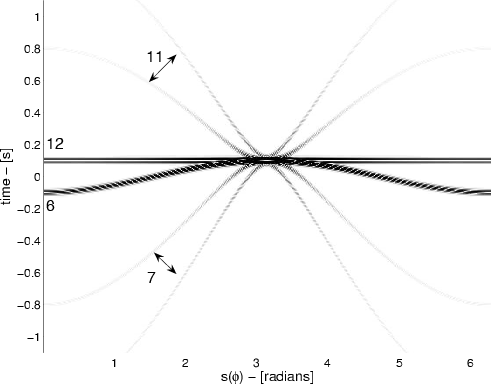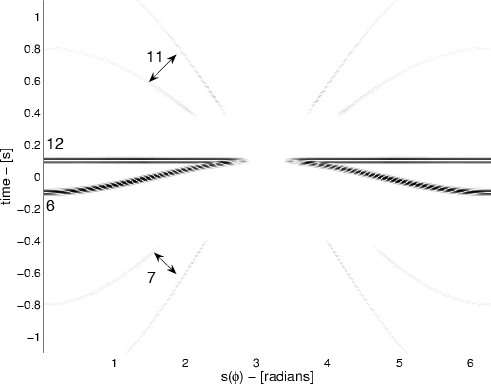|
|
|
|
Kinematics in iterated correlations of a passive acoustic experiment |
This correlogram confirms that when the source, stations ![]() and
and ![]() , an auxiliary station, and the scatterer are aligned, each term has a stationary phase. We also see how term 15.11 is stationary with respect to source postion. The behavior of term 15.6 is similar to that of the leading term in
, an auxiliary station, and the scatterer are aligned, each term has a stationary phase. We also see how term 15.11 is stationary with respect to source postion. The behavior of term 15.6 is similar to that of the leading term in
![]() ; see Figure 4(a). This can be expected from the constraint on
; see Figure 4(a). This can be expected from the constraint on ![]() in condition 25, which is equal to condition 11 on
in condition 25, which is equal to condition 11 on ![]() for
for
![]() . We can expect that when we time-average the
. We can expect that when we time-average the
![]() of multiple sources at different angular positions, term 15.6 interferes destructively.
of multiple sources at different angular positions, term 15.6 interferes destructively.
Figure 12(a) also tells us that terms 15.7 and 15.10 are also non-stationary with respect to source position. However, the arrival time of non-stationary positions is dependent upon scatterer position (see condition 29); this implies that in a medium with randomly positioned scatterers, terms 15.7 and 15.10 would interfere destructively. Last we investigate whether muting ![]() before evaluating
before evaluating
![]() can work for the source postions located at stationary phases for terms 15.6 15.7 and 15.10; see Figure 12(b). We see how muting the
can work for the source postions located at stationary phases for terms 15.6 15.7 and 15.10; see Figure 12(b). We see how muting the
![]() and
and
![]() for source positions at and close to
for source positions at and close to ![]() radians also would remove the energy associated with the scatterer. This is expected, because the scatterer is directly behind the source as seen from both stations
radians also would remove the energy associated with the scatterer. This is expected, because the scatterer is directly behind the source as seen from both stations ![]() and
and ![]() ; thus the contribution arrives simultaneously with the direct event from the source.
; thus the contribution arrives simultaneously with the direct event from the source.


|
|---|
|
corrC4ABSa,corrC4ABSb
Figure 12. a) Gather showing time-domain equivalents of 15.6, 15.7, 15.10 and 15.11 after summing over auxiliary stations as a function of source position angle |
|
|
|
|
|
|
Kinematics in iterated correlations of a passive acoustic experiment |